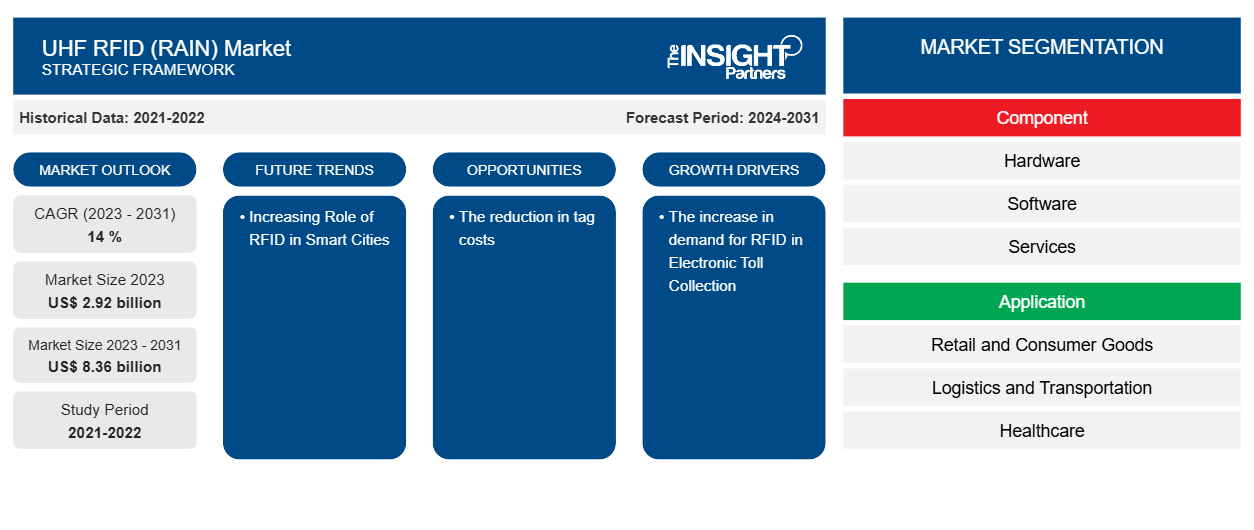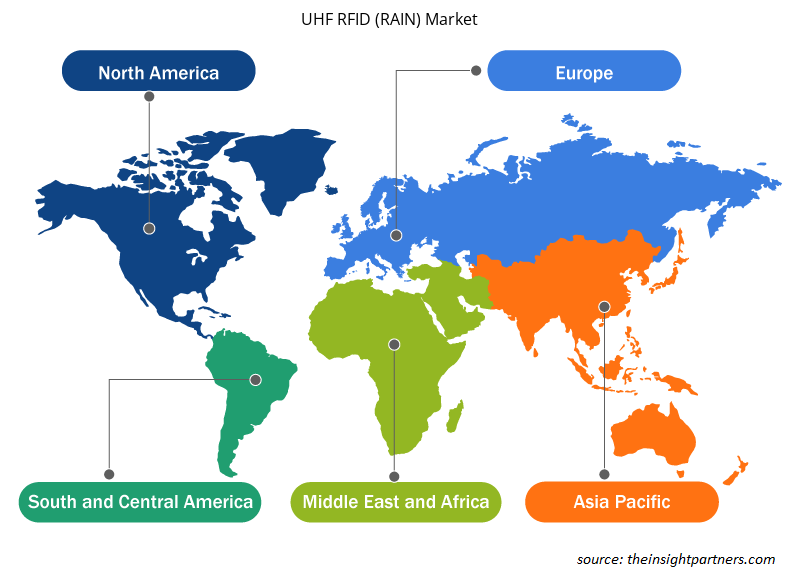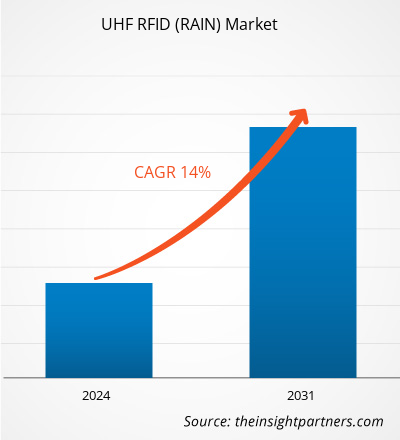من المتوقع أن يصل حجم سوق تقنية UHF RFID (RAIN) إلى 14.07 مليار دولار أمريكي بحلول عام 2031، مقارنةً بـ 4.62 مليار دولار أمريكي في عام 2024. ومن المتوقع أن يسجل السوق معدل نمو سنوي مركب قدره 17.9% خلال الفترة 2025-2031. ومن المرجح أن يُسهم تزايد استخدام هذه التقنية في صناعة السيارات في ظهور اتجاهات جديدة في السوق خلال السنوات القادمة.
تحليل سوق تقنية UHF RFID (RAIN)
RAIN (UHF RFID) هي تقنية لاسلكية تُمكّن المؤسسات والمستهلكين من تحديد مواقع المنتجات الشائعة والتحقق منها والتفاعل معها عبر ربطها بالإنترنت. يقع نطاق RAIN ضمن النطاق الأعلى (بين 860 و960 ميجاهرتز) من نطاق الترددات فائقة الارتفاع لتقنية RFID، ويتوافق مع معايير وبروتوكولات محددة. RAIN RFID هي تقنية سلبية تعمل بترددات فائقة الارتفاع (UHF)، ويمكنها تحديد العناصر من مسافات تصل إلى 15 مترًا. ويمكنها التعرف على ما يصل إلى 1000 عنصر في الثانية، حتى في غياب خط رؤية مباشر. تُدير تقنية RAIN البيانات، وتتخذ الإجراءات اللازمة، وتقرأ وتكتب العناصر المُعلّمة عبر قارئ. تُمكّن هذه القدرات الشركات والعملاء من التعرف على كل عنصر يحمل علامة RAIN، والعثور عليه، والتحقق منه، والتفاعل معه. توفر RAIN بيانات ورؤى شاملة في الوقت الفعلي لتطبيقات مثل تحسين سلسلة التوريد وتتبع الأصول وإدارة المخزون.
نظرة عامة على سوق UHF RFID (RAIN)
تُستخدم تقنية RAIN RFID في الأسواق لتحديد مواقع البضائع والتحقق من صحتها بفعالية. وتتميز عن تقنيات إنترنت الأشياء الأخرى بتوفرها وسعرها المناسب وسهولة استخدامها. إن قدرة RAIN RFID على زيادة وضوح البيانات وتوفيرها بدقة تجعلها تُحدث نقلة نوعية في العصر الرقمي.
قم بتخصيص هذا التقرير ليناسب متطلباتك
ستحصل على تخصيص لأي تقرير - مجانًا - بما في ذلك أجزاء من هذا التقرير، أو تحليل على مستوى الدولة، وحزمة بيانات Excel، بالإضافة إلى الاستفادة من العروض والخصومات الرائعة للشركات الناشئة والجامعات
سوق UHF RFID (RAIN): رؤى استراتيجية

-
احصل على أهم اتجاهات السوق الرئيسية لهذا التقرير.ستتضمن هذه العينة المجانية تحليل البيانات، بدءًا من اتجاهات السوق وحتى التقديرات والتوقعات.
محركات وفرص سوق تقنية UHF RFID (RAIN)
تزايد استخدام تقنيات تحديد الهوية بموجات الراديو في قطاع التجزئة
تُسهم التطورات في تقنيات تتبع المخزون والتركيز على أدوات التسويق الإلكتروني، مثل إعلانات فيسبوك وجوجل، في نمو قطاع التجزئة. يُعدّ هذا القطاع من القطاعات الناضجة في الولايات المتحدة، حيث يميل المستهلكون إلى التسوق الإلكتروني. ووفقًا لبيانات مكتب الإحصاء التابع لوزارة التجارة، بلغت مبيعات التجزئة الإلكترونية في الولايات المتحدة 1192.6 مليار دولار أمريكي في عام 2024، بزيادة قدرها 8.1% عن عام 2023.
في قطاع التجزئة، يُعتمد تحديد الترددات الراديوية (RFID) لوضع علامات على الملابس . يُدمج موردو الملابس الرقمنة وتحليلات البيانات الضخمة في تطبيقات تحديد الترددات الراديوية. تستخدم تقنية تحديد الترددات الراديوية موجات الراديو لنقل البيانات من علامات تحديد الترددات الراديوية إلى قارئ، مما يُمكّن من تحديد هوية الأشياء بناءً على البيانات المُستقبَلة وتسهيل تتبع مواقعها. تبحث المؤسسات عن حلول ميسورة التكلفة تُمكّنها من زيادة كفاءتها التشغيلية وخفض تكاليف التشغيل. تُظهر بيانات من شركة أكسنتشر أن 93% من تجار التجزئة في أمريكا الشمالية يستخدمون تحديد الترددات الراديوية في بعض المجالات لتحقيق هذه الأهداف. تستخدم شركات عملاقة في قطاع التجزئة، مثل إتش آند إم ولولوليمون وزارا ونايكي، تقنية تحديد الترددات الراديوية فائقة التردد (UHF RFID) لإدارة المخزون، مما يُساعدها على الحفاظ على سلسلة توريد فعّالة، ومكافحة المنتجات المقلدة، ومنع حالات نفاد المخزون. في عام 2020، ألزمت وول مارت موردي الملابس بوضع ملصقات تحديد الترددات الراديوية على منتجاتهم. وفي عام 2022، تم توسيع نطاق هذا التكليف ليشمل الألعاب والإلكترونيات وغيرها من الأدوات المنزلية. توسّع نطاق هذا الشرط ليشمل كل شيء، من لوازم السيارات إلى المنتجات الرياضية، في عامي 2023 و2024. وبحلول عام 2025، من المتوقع أن يشمل هذا الشرط غالبية فئات المنتجات الأخرى التي تُباع في متاجر وول مارت. ويساهم تطبيق هذه المبادرات في قطاع التجزئة في دفع نمو السوق في هذا القطاع. RFID) is adopted for digitalization and Big Data analytics in RFID applications. RFID technology utilizes radio waves to transmit data from RFID tags to a reader, enabling the identification of objects based on the received data and facilitating the tracking of their locations. Organizations are seeking affordable solutions that enable them to increase operational efficiencies and reduce overhead costs. Data from Accenture shows that 93% of North American retailers are using RFID in some capacity to achieve these goals. Retail sector giants, such as H&M, Lululemon, Zara, and Nike, use UHF RFID technology for inventory management, helping them maintain an effective supply chain, combat counterfeit items, and prevent out-of-stock situations. Walmart mandated its clothing suppliers to attach RFID labels on their products in 2020. In 2022, the mandate was extended to cover toys, electronics, and other home items. The mandate expanded to cover everything from automotive supply to sporting products in 2023 and 2024. By 2025, the majority of other product categories that are sold in Walmart stores are expected to be covered by the requirement. The implementation of such initiatives in the retail sector drives the market growth in the segment.
نشر تقنية UHF RFID في أجهزة إنترنت الأشياء
إن اعتماد الأجهزة الذكية والاستثمارات الحكومية - لا سيما في دول مثل اليابان وسنغافورة والصين وأستراليا - التي تركز على البحث والتطوير وتركيبات إنترنت الأشياء (IoT) في قطاعات تشمل التصنيع والمرافق وتجارة التجزئة، يُغذي نمو إنترنت الأشياء. تتطلب تطبيقات إنترنت الأشياء اتصالاً بين العالم المادي والرقمي، وتُستخدم تقنية UHF RFID لسد هذه الفجوة. مع ازدهار إنترنت الأشياء، ستتصل غالبية الأجهزة المتصلة بالشبكة لاسلكياً عبر تقنية UHF RFID السلبية، التي تتيح للأجهزة السلبية تبادل بيانات حيوية، والتي يمكن استخدامها لتحديد هذه الأجهزة بدقة من حيث المكان والزمان. تُضيف هذه التقنية ذكاءً إلى منظومة إنترنت الأشياء وتُبسط التطبيقات الجديدة للموارد المتصلة.
في يوليو 2023، أطلقت شركة Impinj, Inc. شرائح بطاقات RAIN RFID من سلسلة Impinj M800 لدعم عمليات نشر إنترنت الأشياء، مما يُحسّن اتصال الأجهزة بالمؤسسات. تُحسّن هذه الشرائح قابلية القراءة والموثوقية وسهولة التصنيع، مما يُحسّن سرعة ونطاق وموثوقية أنظمة RAIN RFID في تتبع الأجهزة المتصلة وتأمينها. يُساعد هذا التكامل الشركات على اتخاذ قرارات مدروسة بناءً على معلومات دقيقة. من خلال ربط بطاقات RFID بالإنترنت، يُمكن للشركات جمع بيانات حول موقع الأجهزة، وأنماط استخدامها، والظروف البيئية، والتي يُمكن استخدامها للتحليلات التنبؤية . وبالتالي، من المتوقع أن يُؤدي دمج تقنية UHF RFID في أجهزة إنترنت الأشياء إلى فرص نمو مستقبلية في السوق.
تقرير تحليل تجزئة سوق UHF RFID (RAIN)
كانت القطاعات الرئيسية التي ساهمت في اشتقاق تحليل سوق UHF RFID (RAIN) هي المكون والتطبيق.
- بناءً على مكوناته، يُقسّم سوق UHF RFID (RAIN) العالمي إلى أجهزة، وبرامج، وخدمات. وقد استحوذ قطاع الأجهزة على الحصة الأكبر في سوق UHF RFID (RAIN) في عام 2024.
- من حيث التطبيق، يُقسّم سوق تقنية UHF RFID (RAIN) إلى قطاعات التجزئة والسلع الاستهلاكية، والخدمات اللوجستية والنقل، والرعاية الصحية، والتصنيع، والسيارات، والفضاء والدفاع، وغيرها. وقد استحوذ قطاع التجزئة والسلع التجارية على الحصة الأكبر في سوق تقنية UHF RFID (RAIN) في عام 2024.
تحليل حصة سوق UHF RFID (RAIN) حسب المنطقة الجغرافية
ينقسم النطاق الجغرافي لتقرير سوق UHF RFID (RAIN) بشكل أساسي إلى خمس مناطق: أمريكا الشمالية، وآسيا والمحيط الهادئ، وأوروبا، والشرق الأوسط وأفريقيا، وأمريكا الجنوبية والوسطى.
ستستحوذ أمريكا الشمالية على حصة سوقية كبيرة في عام 2024. وتُعد الولايات المتحدة الأمريكية وكندا والمكسيك من بين الدول الرئيسية في أمريكا الشمالية. ووفقًا للجنة الاتصالات الفيدرالية (FCC)، تعمل نطاقات UHF بتقنية RFID في المنطقة على نطاق 902-928 ميجاهرتز، حيث ترسل أجهزة القراءة بأقصى طاقة لمعظم هذا النطاق الترددي. في أمريكا الشمالية، تُعتمد تقنية RFID في قطاع التجزئة لنقل البيانات من العلامات المثبتة على الأشياء باستخدام نظام مسح لاسلكي؛ ويخدم هذا النظام بشكل رئيسي غرض التعريف والتتبع التلقائي. تُعزز سهولة التتبع وانخفاض التكلفة وإدارة المخزون الفعالة اعتماد هذه التقنية في قطاع التجزئة في أمريكا الشمالية. ووفقًا لإدارة التجارة الدولية (ITA)، في عام 2022، تجاوز عدد مستخدمي التجارة الإلكترونية في كندا 27 مليون مستخدم، وهو ما يمثل 75% من سكان كندا. ومن المتوقع أن ينمو هذا العدد إلى 77.6% في عام 2025.
يُفاقم قطاع التجزئة المتنامي في أمريكا الشمالية الطلب على تقنية UHF RFID لتتبع مخزونهم بكفاءة. لذا، تميل الشركات بشدة إلى تطوير هذه التقنية لتلبية الاحتياجات المتزايدة لقطاع التجزئة. في مايو 2022، أطلقت شركة Avery Dennison Corporation إضافتين إلى مجموعتها المتوسعة من حشوات RFID ثنائية التردد (DF)، والتي توفر وظائف NFC (HF) وRAIN RFID (UHF) مجتمعة لوضع العلامات على مستوى المنتج بطريقة صغيرة وفعالة من حيث التكلفة. صُممت الحشوات والعلامات AD Medio Web DF EM4425 وAD Web DF EM4425 V12 الجديدة لحماية العلامة التجارية وإدارة سلسلة التوريد والتفاعل مع العملاء. طُوّر AD Medio Web DF لتطبيقات الأدوية والرعاية الصحية، بينما يركز AD Web DF على حالات استخدام التجزئة. واستنادًا إلى خط منتجات AD Web RAIN RFID الناجح من Avery Dennison، يجمع كلا المنتجين بين الأداء الممتاز وإمكانية التردد المزدوج الفريدة. تعمل هذه الأنظمة في نطاقات تردد RFID HF وUHF، وتوفر مزايا كبيرة من حيث التكلفة مقارنة باستخدام اثنين من التطعيمات المنفصلة ذات التردد الواحد.
رؤى إقليمية حول سوق تقنية UHF RFID (RAIN)
قام محللو Insight Partners بشرح شامل للاتجاهات الإقليمية والعوامل المؤثرة في سوق UHF RFID (RAIN) خلال فترة التوقعات. كما يناقش هذا القسم قطاعات سوق UHF RFID (RAIN) ونطاقها الجغرافي في أمريكا الشمالية، وأوروبا، وآسيا والمحيط الهادئ، والشرق الأوسط وأفريقيا، وأمريكا الجنوبية والوسطى.

- احصل على البيانات الإقليمية المحددة لسوق UHF RFID (RAIN)
نطاق تقرير سوق UHF RFID (RAIN)
| سمة التقرير | تفاصيل |
|---|---|
| حجم السوق في عام 2024 | 4.62 مليار دولار أمريكي |
| حجم السوق بحلول عام 2031 | 14.07 مليار دولار أمريكي |
| معدل النمو السنوي المركب العالمي (2025 - 2031) | 17.9% |
| البيانات التاريخية | 2021-2023 |
| فترة التنبؤ | 2025-2031 |
| القطاعات المغطاة |
حسب المكون
|
| المناطق والدول المغطاة |
أمريكا الشمالية
|
| قادة السوق وملفات تعريف الشركات الرئيسية |
|
كثافة اللاعبين في سوق UHF RFID (RAIN): فهم تأثيرها على ديناميكيات الأعمال
يشهد سوق UHF RFID (RAIN) نموًا سريعًا، مدفوعًا بتزايد طلب المستخدمين النهائيين نتيجةً لعوامل مثل تفضيلات المستهلكين المتطورة، والتقدم التكنولوجي، وزيادة الوعي بمزايا المنتج. ومع تزايد الطلب، تعمل الشركات على توسيع عروضها، والابتكار لتلبية احتياجات المستهلكين، والاستفادة من الاتجاهات الناشئة، مما يعزز نمو السوق.
تشير كثافة اللاعبين في السوق إلى توزيع الشركات العاملة في سوق أو قطاع معين. وتشير إلى عدد المنافسين (اللاعبين في السوق) الموجودين في سوق معين نسبةً إلى حجمه أو قيمته السوقية الإجمالية.
الشركات الرئيسية العاملة في سوق UHF RFID (RAIN) هي:
- شركة كاين RFID SRL
- شركة كونفيرجنس سيستمز المحدودة
- شركة إمبينج
- شركة إنفينجو تكنولوجي بي تي إي المحدودة
- جاداك
- شركة لوري سوليوشنز
إخلاء المسؤولية : الشركات المذكورة أعلاه ليست مرتبة بأي ترتيب معين.

- احصل على نظرة عامة على أهم اللاعبين الرئيسيين في سوق UHF RFID (RAIN)
أخبار سوق UHF RFID (RAIN) والتطورات الأخيرة
يُقيّم سوق تقنية UHF RFID (RAIN) بجمع بيانات نوعية وكمية بعد البحث الأولي والثانوي، والتي تشمل منشورات الشركات المهمة، وبيانات الجمعيات، وقواعد البيانات. فيما يلي بعض التطورات في سوق تقنية UHF RFID (RAIN):
- أعلنت شركة أفيري دينيسون عن توسيع نطاق منتجاتها AD Pure، وهي مجموعة من الحشوات والعلامات الخالية تمامًا من بلاستيك البولي إيثيلين تيرفثالات (PET). تُصنع حشوات وعلامات AD Pure بشكل مستدام باستخدام تقنية تصنيع هوائيات مبتكرة. يُثبّت الهوائي والرقائق مباشرةً على الورق، مما يجعل المجموعة خالية تمامًا من البلاستيك. (المصدر: أفيري دينيسون، بيان صحفي، أبريل ٢٠٢٤)
- استحوذت شركة Checkpoint Systems على أنظمة تنبيه لتعزيز مجموعة حلولها لمكافحة الجرائم المنظمة في قطاع التجزئة، مع التركيز على كشف المعادن والمغناطيس في قطاع التجزئة. (المصدر: Checkpoint Systems، بيان صحفي، أبريل ٢٠٢٣)
تغطية تقرير سوق UHF RFID (RAIN) والمنتجات النهائية
يقدم تقرير "حجم سوق UHF RFID (RAIN) والتوقعات (2021-2031)" تحليلاً مفصلاً للسوق يغطي المجالات التالية:
- حجم سوق UHF RFID (RAIN) وتوقعاته على المستويات العالمية والإقليمية والوطنية لجميع قطاعات السوق الرئيسية التي يغطيها النطاق
- اتجاهات سوق UHF RFID (RAIN)، بالإضافة إلى ديناميكيات السوق مثل المحركات والقيود والفرص الرئيسية
- تحليل مفصل لـ PEST و SWOT
- تحليل سوق UHF RFID (RAIN) يغطي اتجاهات السوق الرئيسية والإطار العالمي والإقليمي والجهات الفاعلة الرئيسية واللوائح والتطورات الأخيرة في السوق
- تحليل المشهد الصناعي والمنافسة الذي يغطي تركيز السوق، وتحليل خريطة الحرارة، واللاعبين البارزين، والتطورات الأخيرة لسوق UHF RFID (RAIN)
- ملفات تعريف الشركة التفصيلية
- التحليل التاريخي (سنتان)، سنة الأساس، التوقعات (7 سنوات) مع معدل النمو السنوي المركب
- تحليل PEST و SWOT
- حجم السوق والقيمة / الحجم - عالمي، إقليمي، بلد
- الصناعة والمنافسة
- مجموعة بيانات إكسل
التقارير الحديثة
شهادات العملاء
سبب الشراء
- اتخاذ قرارات مدروسة
- فهم ديناميكيات السوق
- تحليل المنافسة
- رؤى العملاء
- توقعات السوق
- تخفيف المخاطر
- التخطيط الاستراتيجي
- مبررات الاستثمار
- تحديد الأسواق الناشئة
- تحسين استراتيجيات التسويق
- تعزيز الكفاءة التشغيلية
- مواكبة التوجهات التنظيمية






















 احصل على عينة مجانية ل - سوق UHF RFID (RAIN)
احصل على عينة مجانية ل - سوق UHF RFID (RAIN)